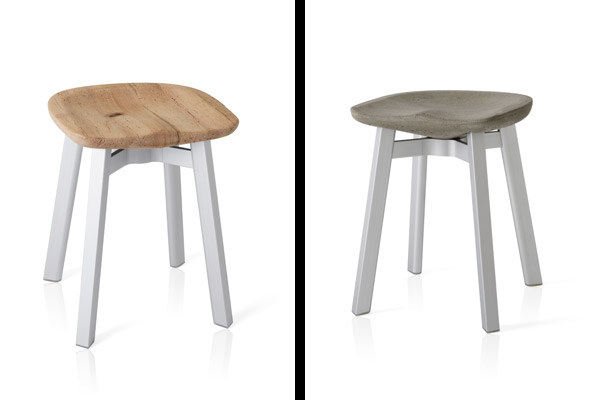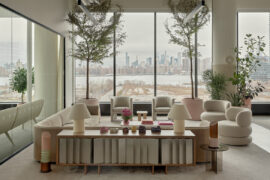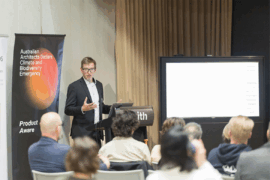Gregg Buchbinder, President and CEO of Emeco, tells us about their journey with Nendo’s Oki Sato: from their first inspiration and discussions to the outcomes of their collaboration. Yvonne Xu has the story.

June 19th, 2014
Top image: (left) Gregg Buchbinder, President and CEO of Emeco; (right) Oki Sato, founder of Nendo
In Japan, ‘su’ refers to ideas of simplicity, plainness, and minimalism. In collaboration with Japanese design studio Nendo, Emeco has launched the SU Collection – a stripped-down set of stools and tables that considers the ‘bones’ of the Emeco brand. The collection was launched at the Salone Internazionale del Mobile earlier this April, and features precise engineering and the use of new, eco-conscious materials such as green concrete and solid reclaimed oak sourced from old architecture in the United States. We find out more.

Emeco SU by Nendo stool collection: (Left) wood with aluminum legs; (Right) concrete with aluminium legs
You contacted Oki Sato after seeing his design of the Starbucks pop-up store in Tokyo in 2012, where several 111 Navy Chairs were used. How did that project impress you?
What impressed me so much about the Starbucks installation was that the Nendo approach was stripped down to the bare minimum – only three chairs for the whole installation. It was simple, clean, refreshing. It felt really good. It told me a lot about Oki Sato – that his mindset was to reduce and simplify. The materials were very focused.

(Left) Wood with legs painted black; (Right) Concrete with legs painted black
What ideas did you explore with him?
Most people think of the Navy chair, and look at how we would be able to reduce it further and make it simpler. I met Oki Sato at Kortrijk (trade fair) and the nature of our conversations were more about his values, vision, and philosophy – the big picture – the idea of looking at the bones of Emeco. It was an interesting conversation because it revolved around his passion and his focus.

Recycled polyethylene with aluminium legs
How was the form of the barstool derived? The footrest is interesting.
The form of the seat again followed the idea of Emeco ‘bones’ and was patterned directly from the Emeco Navy chair seat bottom, which is said to have been made to fit the bottom of 1940s actress Betty Grable. The footrest was designed to be integral, simple and strong. The design is clean; the footrest is unobtrusive and fits flush.
How does this collection sit within the Emeco family of chairs?
The SU collection fits our higher purpose in many ways. One – the focus is on using reclaimed, upcycled, or waste materials in a way to give them a long life. Two – like all of our chairs, SU is a product of collaboration with one of the top thinkers in the industry. Oki Sato fits that category. The collaboration is intelligent and the product is made to last. Design, engineering, and material come together with the intention to last decades.

(Left) Recycled polyethylene with aluminium legs; (Right) Wood with aluminium legs
Did you explore new technical innovations?
A big portion of this project was to explore new materials. We used reclaimed, locally-sourced wood from old barns in Lancaster County, Pennsylvania; old cork material which we used in a prototype and which we are still exploring; and eco-concrete, the new CSA concrete formula which is green concrete mixed with recycled glass, so it is 50% recycled consumer waste mixed with green concrete. SU also features another seat of 100% recycled polyethylene – made from recycled milk jugs. Part of this was an exploration to see what is most appropriate, and what in the end makes for the best product.
Another decision was to focus on the engineering, which became a vital part of the chair. All the components come together in a strong structural way. That’s a focus for Emeco but not usually normal practice for how other companies make their chairs.

Su table, featured in the middle
What is distinctive about this collection for you?
I believe that the materials we have chosen, and the engineering, are both distinctive about the Emeco SU by Nendo stool collection. I’ve discussed the eco-conscious material exploration already. The engineering is remarkable and very precise to reflect the goals of both Emeco and Nendo to make everything you don’t see as beautiful as everything that meets the eye.
The seats all attach by one simple screw – you can use a coin to remove the whole seat and change it out. Emeco chairs, such as the Navy Chair, are crafted by welding them into one piece, but SU has components with superb engineering that are cleverly assembled and constructed to be very strong.
Emeco
emeco.net
Nendo
nendo.jp/en/
Emeco is carried in Singapore at Space Furniture.
INDESIGN is on instagram
Follow @indesignlive
A searchable and comprehensive guide for specifying leading products and their suppliers
Keep up to date with the latest and greatest from our industry BFF's!

London-based design duo Raw Edges have joined forces with Established & Sons and Tongue & Groove to introduce Wall to Wall – a hand-stained, “living collection” that transforms parquet flooring into a canvas of colour, pattern, and possibility.

The undeniable thread connecting Herman Miller and Knoll’s design legacies across the decades now finds its profound physical embodiment at MillerKnoll’s new Design Yard Archives.

Lighting becomes storytelling in the hands of Bocci and Moooi – brands championed by Space Furniture.

Space Furniture has opened the world’s first standalone B&B Italia Outdoor showroom, a landmark space celebrating an enduring partnership of over 30 years with B&B Italia.
The internet never sleeps! Here's the stuff you might have missed

CPD Live’s final live-presented season for 2025 continues with a powerful Day 2 lineup, delving into façade weatherproofing, apartment design trends, smart bathrooms, and digital compliance. Starting from 9 AM AEDT, these free CPD-accredited sessions will help you finish the year with fresh insight and full compliance confidence.

The New York headquarters of haircare brand, Amika, has been designed by Civilian as the antithesis of a standard business hub.

Type designer Vincent Chan, who delivered a keynote speech with the Powerhouse as part of Sydney Design Week, tells us about the history and importance of this niche profession.

In a landscape clouded by data and greenwash, Product Aware offers architects and designers a common language for sustainability. Embraced by suppliers – including Milliken – it is setting a new benchmark for trust and bringing clarity and accountability to material specification.